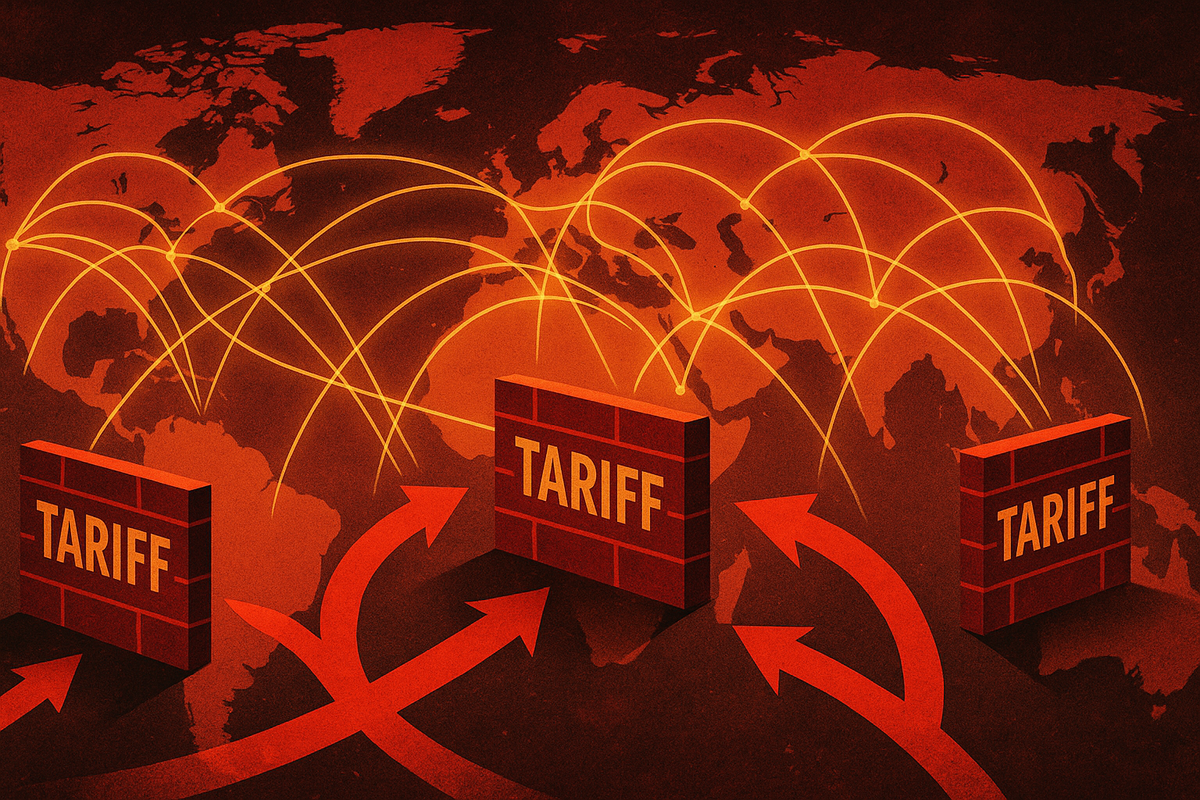
The global economic landscape is once again grappling with the profound implications of President Donald Trump's renewed tariff policies. As of August 2025, a sweeping wave of new import duties has taken effect, dramatically reshaping international trade relations and sending ripples of uncertainty through financial markets worldwide. These tariffs, which have seen the average applied U.S. tariff rate surge to an estimated 18.4% by July 2025—its highest level in over a century—are designed to protect domestic industries but are simultaneously triggering retaliatory measures and raising concerns about global economic contraction.
The immediate fallout includes heightened volatility in stock markets, a complex and evolving impact on the U.S. dollar, and significant cost increases for businesses and consumers. The sheer scale of these tariffs, affecting nearly all goods imported into the United States from a broad spectrum of nations, underscores a deliberate and aggressive shift in U.S. trade strategy, with far-reaching consequences for supply chains, corporate profitability, and household budgets.
The Unfolding Trade War: What Happened and Why It Matters
The current escalation of trade tensions under President Trump's administration in 2025 marks a significant turning point in global commerce. A universal 10% tariff on most imports took effect on April 5, 2025, with higher rates, ranging from 10% to 41%, subsequently applied to 92 nations by August 7, 2025. This aggressive stance is rooted in a protectionist ideology aimed at rebalancing trade deficits and bolstering American manufacturing.
The timeline of these events has been swift and impactful. Following the initial universal tariff, country-specific duties were rapidly rolled out. The ongoing trade war with China, a carryover from previous administrations, has seen U.S. baseline tariffs on Chinese goods peak at 145%, with Chinese retaliatory tariffs reaching 125%. While a temporary truce had reduced these rates, speculation suggests a resumption of country-specific "reciprocal tariffs" is imminent. The European Union (EU) faces a 15% tariff on most goods, with steel and aluminum imports continuing to be taxed at a hefty 50%. Canada and Mexico, despite the USMCA agreement, have also seen tariff increases, with Mexico facing a 25% tariff on all imports in 2025, projected to rise to 30% by November 1.
A particularly notable development is the planned hike on India. On July 30, 2025, a 25% tariff was announced on imports from India, with a potential additional 10% "penalty" for BRICS countries, bringing effective tariffs to 35%. Furthermore, legislation is reportedly in process that could impose an additional 500% tariff on India, China, and Brazil for their dealings with Russia, signaling a broader geopolitical dimension to these trade policies. Japan, however, has secured a more favorable agreement, with tariffs on its goods, including automobiles, set at 15%. Brazil faces 50% tariffs with some exemptions, and Vietnam has agreed to a 20% tariff on its exports to the U.S.
Key players in this unfolding drama include the U.S. Treasury Department, which reported a record $29 billion in tariff revenues collected in July 2025—the highest monthly total for the year, pushing cumulative revenue to over $152 billion. This surge in revenue, while significant, still represents a relatively small portion of overall federal income. The initial market reactions have been largely negative, with the S&P 500 (NYSEARCA: SPY) experiencing its deepest decline in 2025 after the new tariffs were announced in April. The Dow Jones Industrial Average (NYSEARCA: DIA) also fell significantly, reflecting widespread concerns over a full-blown trade war and its potential to disrupt global supply chains and dampen economic growth.
Winners and Losers in the Tariff Tug-of-War
The imposition of widespread tariffs inevitably creates a complex web of winners and losers across industries and national economies. While the stated aim is to protect domestic industries, the ripple effects often extend far beyond the intended beneficiaries.
Potential Winners:
- Domestic Steel and Aluminum Producers: U.S. steel and aluminum manufacturers could see increased demand and higher prices for their products due to the 50% tariffs on imports from the EU and other nations. Companies like United States Steel Corporation (NYSE: X) and Alcoa Corporation (NYSE: AA) might experience a boost in their domestic market share.
- Certain Domestic Manufacturers: Industries that compete directly with heavily tariffed imports, particularly those with robust domestic supply chains, might gain a competitive edge. This could include some segments of the U.S. automotive industry, though the overall impact on this sector is largely negative due to increased input costs.
- The U.S. Treasury: As evidenced by the record $29 billion in tariff revenues collected in July 2025, the U.S. government is a direct beneficiary in terms of increased federal income.
Potential Losers:
- U.S. Consumers: Tariffs are essentially taxes on imported goods, and these costs are largely passed on to consumers through higher prices. The Penn Wharton Budget Model projects that these tariffs could result in a lifetime loss of $22,000 for a middle-income household, with an estimated average cost of $2,400 per American household in 2025.
- Importers and Retailers: Companies that rely heavily on imported goods, such as major retailers like Walmart Inc. (NYSE: WMT) and Target Corporation (NYSE: TGT), will face increased sourcing costs, which can erode profit margins or necessitate price increases for consumers.
- Industries Reliant on Imported Inputs: Sectors that depend on imported raw materials or components will see their production costs rise. This includes the automotive industry, which relies on imported steel and aluminum, and the technology sector, particularly companies like Apple Inc. (NASDAQ: AAPL) and Samsung Electronics Co., Ltd. (KRX: 005930), which source components globally. Taiwan Semiconductor Manufacturing Company Limited (NYSE: TSM), which produces over 90% of the world's high-tech chips, faces a 20% tariff, directly impacting the cost of electronics.
- Agricultural Sector: U.S. agricultural exports are often targets of retaliatory tariffs from trade partners, leading to reduced demand and lower prices for American farmers.
- Downstream Industries: Industries that use steel and aluminum, such as canned food producers, beverage companies, and the real estate and construction sectors, will face higher input costs, potentially leading to inflated domestic prices and reduced profitability.
- Global Trade Partners: Nations like India, China, and the EU, facing significant tariffs on their exports to the U.S., will see reduced market access and economic strain. Their industries will suffer from decreased demand, potentially leading to job losses and economic slowdowns in those countries.
The impact on shares has been largely negative, with U.S. stocks selling off when tariff talks break down or new duties are applied. The "erratic nature" of tariff implementation has created significant uncertainty, leading to market swings. The U.S. dollar's reaction has been more nuanced; while initial tariff announcements in 2018-2019 sometimes bolstered the dollar as a safe-haven currency, more recent reports from July-August 2025 indicate a weakening of the U.S. dollar against currencies like the Japanese Yen (JPY=X) and the Euro (EUR=X), suggesting that sustained tariffs, coupled with other economic factors, may be eroding its strength.
Industry Impact and Broader Implications
The current wave of tariffs is not merely a series of isolated trade disputes; it represents a fundamental shift in global economic policy with profound and far-reaching implications for industries worldwide. This event fits into a broader trend of increasing economic nationalism and protectionism, challenging the decades-long movement towards globalization and free trade.
The most immediate and significant ripple effect is the disruption of global supply chains. Companies have spent years optimizing their supply networks for efficiency and cost-effectiveness, often relying on international sourcing. Tariffs force a costly re-evaluation, potentially leading to reshoring or diversification of suppliers, which can be expensive and time-consuming. This uncertainty has already led some manufacturers to decrease production and staff, as reported by various business surveys.
Inflationary pressures are another critical consequence. As import costs rise due to tariffs, these expenses are inevitably passed on to consumers, contributing to higher prices for a wide range of goods. This could dampen consumer spending and potentially lead to broader economic slowdowns. The increased cost of raw materials also squeezes profit margins for businesses, impacting their ability to invest and grow.
From a regulatory and policy perspective, these tariffs signal a more interventionist approach to trade. They challenge the established norms of international trade agreements and institutions like the World Trade Organization (WTO), potentially leading to a more fragmented and less predictable global trading environment. The threat of escalating retaliatory tariffs from affected nations creates a tit-for-tat dynamic that can quickly spiral into a full-blown trade war, harming all parties involved.
Historically, trade wars have rarely yielded clear winners and often result in economic contraction for all participants. Comparisons can be drawn to the Smoot-Hawley Tariff Act of 1930, which is widely considered to have exacerbated the Great Depression by stifling international trade. While the current situation differs in scale and context, the underlying principle remains: erecting trade barriers can lead to reduced global trade volumes, decreased economic efficiency, and a general decline in prosperity. The 2018-2019 trade war under the previous Trump administration also serves as a recent precedent, demonstrating how tariff uncertainty can wreak havoc on stock markets and business confidence.
What Comes Next
The path forward in this tariff-laden landscape is fraught with both challenges and potential strategic shifts. In the short term, continued market volatility is almost a certainty. Investors and businesses will remain highly sensitive to any new tariff announcements, retaliatory measures, or signs of de-escalation. The immediate focus for many companies will be on managing increased costs and navigating disrupted supply chains.
In the long term, several possibilities emerge. One scenario involves a sustained period of elevated tariffs, forcing companies to fundamentally restructure their global operations. This could lead to significant strategic pivots, such as accelerated reshoring of manufacturing to the U.S. or diversification of supply chains away from heavily tariffed countries. While this might create some domestic manufacturing jobs, it would also likely result in higher consumer prices and potentially reduced global economic efficiency.
Another possibility is that the tariffs serve as leverage for new trade negotiations, eventually leading to revised agreements that reduce or eliminate some of the current duties. However, the current aggressive stance suggests a willingness to endure economic pain for perceived strategic gains.
For the market, challenges include sustained inflationary pressures, reduced corporate earnings due to higher input costs, and a general dampening of economic growth. Opportunities might emerge for domestic industries that are now more competitive against imports, as well as for companies that can successfully adapt their supply chains or innovate to mitigate tariff impacts. For instance, logistics and warehousing companies might see increased demand as businesses adjust their inventory strategies.
Potential outcomes range from a full-blown global trade war, leading to a significant economic downturn, to a more managed de-escalation as countries find common ground. The trajectory will largely depend on the political will of the U.S. administration and the responses of its trade partners.
Conclusion: Navigating the New Trade Reality
President Trump's new tariffs represent a seismic shift in global trade policy, with profound and multifaceted implications for the financial markets and the broader economy. The record $29 billion in tariff revenues collected in July 2025 underscores the scale of these duties, but this revenue comes at a significant cost to consumers and businesses alike.
The key takeaways from this event are clear: increased economic uncertainty, rising costs for consumers, disrupted global supply chains, and a volatile stock market. While some domestic industries may see short-term benefits, the overall impact is likely to be a drag on global economic growth and a challenge to the interconnectedness that has defined modern commerce. The complex and evolving impact on the U.S. dollar further highlights the unpredictable nature of these policies.
Moving forward, investors should closely watch for several key indicators. These include:
- Further tariff announcements and retaliatory measures: Any escalation or de-escalation will directly impact market sentiment.
- Inflation data: Rising consumer prices will be a critical indicator of the tariffs' impact on household budgets and overall economic health.
- Corporate earnings reports: Companies' abilities to absorb or pass on increased costs will be reflected in their financial performance.
- Global trade volumes: A significant decline in international trade would signal a deeper economic contraction.
- Supply chain adjustments: Observe how companies adapt their sourcing and manufacturing strategies in response to the new trade reality.
The lasting impact of these tariffs could be a fundamental reshaping of global supply chains, a re-evaluation of trade agreements, and a more fragmented international economic order. Businesses and investors must adapt to this new trade reality, prioritizing resilience and strategic flexibility in an increasingly unpredictable global marketplace. The tariff tempest is far from over, and its full economic and geopolitical consequences will continue to unfold in the months and years to come.




